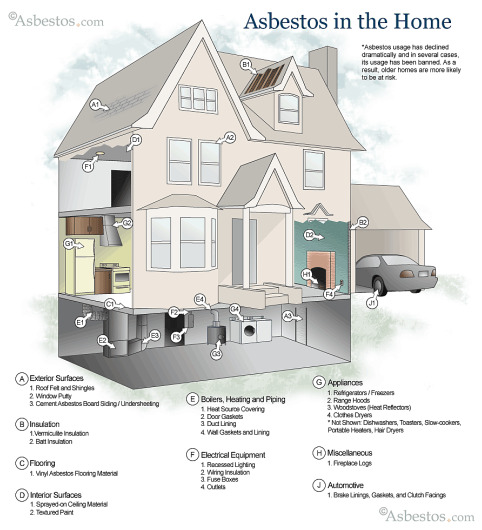I was contacted by the Mesothelioma Cancer Center to bring awareness to the hazards of asbestos. Asbestos can be found in the insulation of many Pasadena homes built prior to 1980.
When home owners remodel, they may expose themselves to asbestos, which could lead to the deadly cancer called mesothelioma. There are many environmentally safe and healthy ways to insulate your home and this article written by Paul James, one of the site’s editors, discusses this issue.

Asbestos usage has declined dramatically, and in several cases, its usage has been banned. As a result, older homes are likely to be at risk.
Asbestos in the Home – Prevention & Healthy Alternatives
Located in the Southwestern part of the United States, California is known for its beautiful weather, gorgeous scenery, arts, culture, entertainment industry and tourism. The state of California provides a great environment for active lifestyles and is regarded as one of the top states to call home.
When searching for a new home or apartment in the state, there are many things to consider. Newly bought homes are often remodeled and repairs are always needed. Having the assistance of an honest real estate agent can make all the difference in the many steps that lead to homeownership.
Renowned for a large industrial history, California’s economy has had success in areas such as ship-building, mining and power generation. These industries found many usages for asbestos, as the material has fire and heat resistant qualities. Although asbestos exposure does not always pose health risks, it is still highly recommended that homebuyers determine if asbestos containing building materials are present. Exposure to asbestos is easily avoidable by taking simple precautions. The state is also leading the way towards a green paradigm, featuring eco-sustainable methods of construction and living. Many of these healthy insulation options are available for home use. Not only do these materials replace the need for hazardous materials, they can even reduce annual energy costs.
If you find asbestos in the home, you shouldn’t panic. Most asbestos that is in good condition does not pose any health risks. Most experts suggest leaving it un-disturbed until an inspector can determine the legitimacy of concerns. Asbestos still regularly appears in roof shingles, dry wall, attic insulation, popcorn ceilings, joint compounds and electrical wires.
The long term inhalation of airborne asbestos fibers can cause a rare, but severe lung ailment known as mesothelioma.
Manufacturers of asbestos were aware of its toxic qualities, but repressed any evidence that demonstrated that. Mesothelioma treatment has varied affects on patients and many variables can affect patient prognosis. These include latency period, age of diagnosis and cigarette smoking.
There are a number of factors that can impact mesothelioma survival rate. These factors include latency period, age of diagnosis and cigarette smoking.
GREEN better for your Health and Your Pocket
Implementing and enforcing the state’s environmental protection laws, The California Environmental Protection Agency ensures clean water, air, soil and waste recycling is performed throughout the state. This agency is at the forefront of science and research to lead to a cleaner, healthier planet for all. The implementation of green alternatives such as cotton fiber, lcynene foam and cellulose can reduce annual energy costs by 25 percent.
Cotton fiber is also becoming a favorite insulation method. Made from recycled batted material, it is then treated to be fireproof. Water based spray polyurethane foam, lcynene, is a healthy insulation which contains no toxic components.
Tax breaks are being offered through The American Recovery and Reinvestment Tax Act of 2009. This package extends energy efficiency tax incentives first enacted in 2005 and even creates some new ones for those who remodel their homes using eco-friendly materials.
This is good news for people looking to remodel their homes. Some of the measures eligible for tax credits include:
- Replacement windows and skylights which are equal or below a 0.30 U factor
- Window films certified by the manufacturer that the product meets the requirements of a green insulation system
- Pigmented metal or asphalt roofs that meet Energy Star requirements
- Added insulation to walls or any part of a structure that meets the 2009 IECC specifications.

